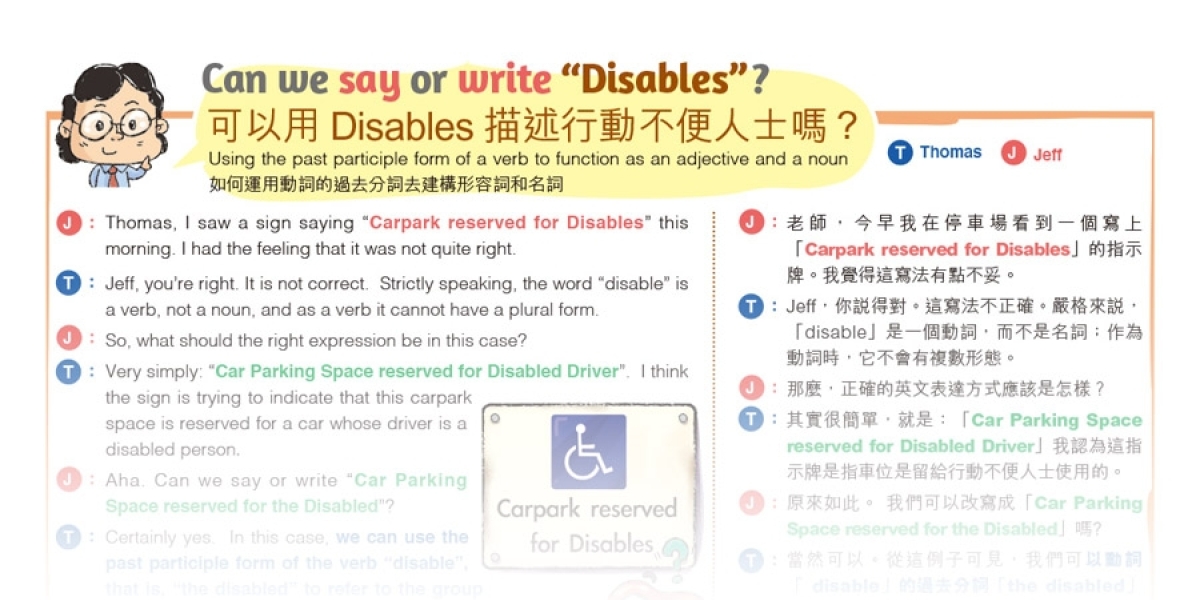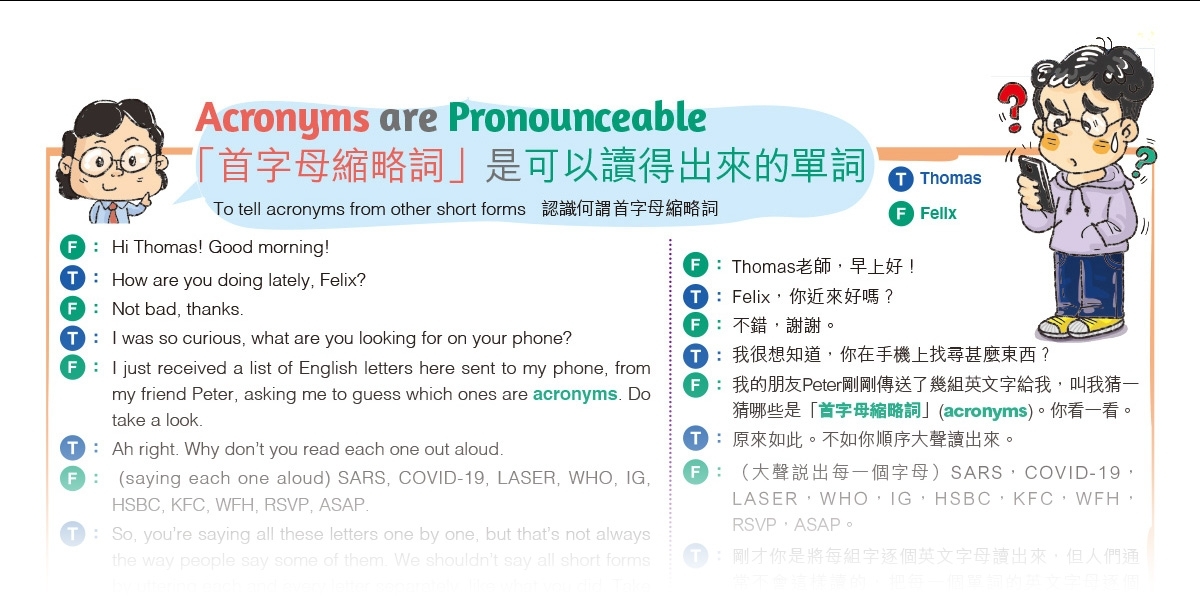昔日文章


Learning English with Thomas
2022.10.30
Can we say or write “Disables” ?
可以用Disables 描述行動不便人士嗎?
T: Thomas J=Jeff
Using the past participle form of a verb to function as an adjective and a noun
J: Thomas, I saw a sign saying “Carpark reserved for Disables” this morning. I had the feeling that it was not quite right.
T: Jeff, you’re right. It is not correct. Strictly speaking, the word “disable” is a verb, not a noun, and as a verb it cannot have a plural form.
J: So, what should the right expression be in this case?
T: Very simply: “Car Parking Space reserved for Disabled Driver”. I think the sign is trying to indicate that this carpark space is reserved for a car whose driver is a disabled person.
J: Aha. Can we say or write “Car Parking Space reserved for the Disabled”?
T: Certainly yes. In this case, we can use the past participle form of the verb “disable”, that is, “the disabled” to refer to the group of people under description, like “the rich”, “the poor”, “the privileged”, etc. See?
J: Loud and clear, Sir. And thank you, Sir.
如何運用動詞的過去分詞去建構形容詞和名詞
J: 老師, 今早我在停車場看到一個寫上「Carpark reserved for Disables」的指示牌。我覺得這寫法有點不妥。
T: Jeff,你說得對。這寫法不正確。嚴格來說, 「disable」是一個動詞,而不是名詞;作為動詞時,它不會有複數形態。
J: 那麼,正確的英文表達方式應該是怎樣?
T: 其實很簡單,就是:「Car Parking Space reserved for Disabled Driver」我認為這指示牌是指車位是留給行動不便人士使用的。
J: 原來如此。 我們可以改寫成「Car Parking Space reserved for the Disabled」嗎?
T: 當然可以。從這例子可見,我們可以動詞「 disable」的過去分詞「the disabled」來描述一個群體, 例如: 「t h e r i c h 」(富人) ,「the poor」(窮人), 「the privileged」(特權人士) 等等,明白嗎?
J: 你的解釋很清楚。謝謝老師。


Learning English with Thomas
2022.10.23
Acronyms are Pronounceable
「首字母縮略詞」是可以讀得出來的單詞
T : Thomas F : Felix
To tell acronyms from other short forms 認識何謂首字母縮略詞
F : Hi Thomas! Good morning!
T : How are you doing lately, Felix?
F : Not bad, thanks.
T : I was so curious, what are you looking for on your phone?
F : I just received a list of English letters here sent to my phone, from my friend Peter, asking me to guess which ones are acronyms. Do take a look.
T : Ah right. Why don’t you read each one out aloud.
F : (saying each one aloud) SARS, COVID-19, LASER, WHO, IG, HSBC, KFC, WFH, RSVP, ASAP.
T : So, you’re saying all these letters one by one, but that’s not always the way people say some of them. We shouldn’t say all short forms by uttering each and every letter separately, like what you did. Take the first three you named. We should pronounce each of them like we pronounce any other English word, as a word in each case and not as separate letters. Take these three as examples: Sars; Covid nineteen; layser. These are called acronyms.
F : Very clear now. Thanks a lot
F :Thomas老師,早上好!
T : Felix,你近來好嗎?
F :不錯,謝謝。
T : 我很想知道,你在手機上找尋甚麼東西?
F :我的朋友Peter剛剛傳送了幾組英文字給我,叫我猜一猜哪些是「首字母縮略詞」(acronyms)。你看一看。
T : 原來如此。不如你順序大聲讀出來。
F :(大聲說出每一個字母)SARS,COVID-19, L A S E R , W H O , I G , H S B C , K F C , W F H , RSVP,ASAP。
T : 剛才你是將每組字逐個英文字母讀出來,但人們通常不會這樣讀的,把每一個單詞的英文字母逐個讀出來並不恰當,像你那樣。有些詞應該用平日處理英文單詞的讀法(即以一個詞為單位)去發音,譬如首三個例子:Sars;Covid nineteen; Layser。它們都稱為「首字母縮略詞」。
F :我現在明白了。謝謝。


Learning English with Thomas
2022.10.16
Knowing about abbreviations starting from KOL
英文縮寫知多少﹖從KOL 一詞談起
To determine what counts as abbreviation
認識何謂英文縮寫 (abbreviations)
T : Thomas P : Peter
P : Excuse me, Sir. Do you have a minute to spare?
T : Hello Peter. What can I do for you?
P : Can you tell me what’s common to these groups of letters? Like: KOL, WFH, WHO, IG, HSBC, KFC.
T : Sure. KOL, WFH, WHO, IG, HSBC, KFC, and similar short forms, are what are called abbreviations in English. We just take the first letter of each of such words making up the phrase to give you the short form, like K-O-L taking K from the word Key, O from the word Opinion and L from the word Leader. And the same rule goes for the other examples.
P : So, K-O-L for Key Opinion Leader, W-F-H for Working from Home, I-G for Instagram; H-S-B-C for Hong Kong and Shanghai Banking Corporation; and K-F-C for Kentucky Fried Chickens?
T :Right. All correct! Your effort is very promising (speaking smilingly as if to himself ) !
P : 老師,不好意思,你有空嗎?
T : Peter,您好!我有甚麼事可以幫忙?
P : KOL,WFH,WHO,IG,HSBC,KFC等字有甚麼共通點?
T : 好的。它們都是「縮寫」,英文稱為abbreviation。這些縮寫的組合是提取該詞組裡每個單詞的第一個英文字母來組成。以K-O-L為例,從單詞Key中取出K,從單詞Opinion中取出O,從單詞Leader中取出L。同樣的規則也適用於其他例子。
P : 所以,W-F-H是Working from Home的縮寫,Instagram的縮寫是 I-G;香港上海匯豐銀行的英文縮寫是 H-S-B-C,以及肯德基炸雞的縮寫是 K-F-C。
T : 對,完全正確!孺子可教也!(老師欣慰地點頭微笑)


Learning English with Thomas
2022.10.09
Working from home or Working at home
遙距辦公或在家工作
Special use of " from" in " working from home " 如何運用Working from home
T : Thomas J : Jason
J : Excuse me, sir. Have you seen Miss Chan today? I just tried to find her in her office, but she wasn’t there.
T : Hi Jason. Miss Chan is working from home today. Are you looking for her for some business?
J : Right. But why are you saying that she is working from home? Why aren’t you saying that she is working at home, since she is clearly at home, isn’t she?
T : Haha, good question Jason. I can assure you : Miss Chan is really working from home now. This is a common English expression to indicate that, thanks to IT, someone is able to work away from the office or workplace. The preposition from in this case isn’t referring to a place or location, but rather to how she works. On the other hand, the expresion “working at home” is using the preposition at to refer to a place : her home. Can you tell the difference now?
J : Yes, very clear sir. I look forward to more from you sir next time.
J : 老師,你好, 你今天見過陳老師嗎? 我剛才去了她的辦公室卻找不到她。
T : H i J a s o n , 陳老師今天遙距辦公( w o r k i n g f r o m home),你有甚麼事找她?
J : 為何你說她「working from home」而不是「working at home」? 陳老師現在明明是在家工作,不是嗎?
T : 哈哈,Jason你問得好好。我向你保證,陳老師是在家工作。「遙距辦公」(working from home) 是英文慣用語,意指透過資訊科技在辦公室之外的處所工作——可以在家中或者其他地方。在這種情況下,介詞from不是指一個地方或地點,而是指她的工作方式。
反觀,「working at home」是另一種表達方式,使用介詞at來指出工作的處所——在家裡工作。現在,你能夠區分到兩者的分別嗎﹖
J : 我明白了,非常清晰。下次再向老師請教。


